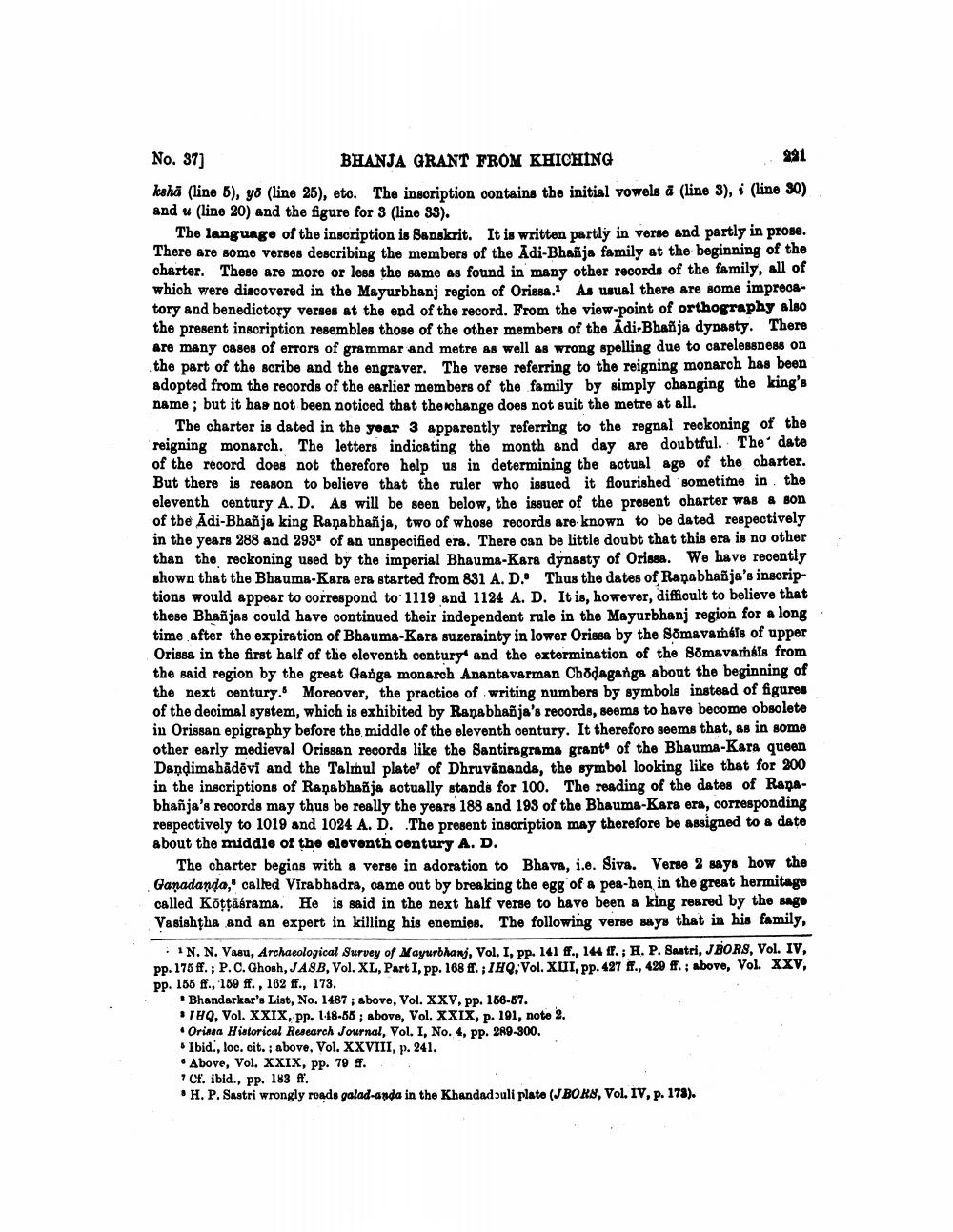________________
No. 37]
BHANJA GRANT FROM KHICHING kaha (line 5), yo (line 25), eto. The insoription contains the initial vowels à (line 3), 1 (line 30) and (line 20) and the figure for 3 (line 83).
The language of the inscription is Sanskrit. It is written partly in verse and partly in prose. There are some verses describing the members of the Adi-Bhaħja family at the beginning of the charter. These are more or less the same as found in many other records of the family, all of which were discovered in the Mayurbhanj region of Orissa. As usual there are some imprecatory and benedictory Verses at the end of the record. From the view point of orthography also the present inscription resembles those of the other members of the Adi-Bhañja dynasty. There are many cases of errors of grammar and metre as well as wrong spelling due to carelessness on the part of the scribe and the engraver. The verse referring to the reigning monarch has been adopted from the records of the earlier members of the family by simply changing the king's name; but it has not been noticed that the change does not suit the metre at all.
The charter is dated in the yoar 3 apparently referring to the regnal reckoning of the reigning monarch. The letters indicating the month and day are doubtful. The' date of the record does not therefore help us in determining the actual age of the obarter. But there is reason to believe that the ruler who issued it Aourished sometime in the eleventh century A. D. As will be seen below. the issuer of the present charter was & son of the Adi-Bhañja king Ranabhañja, two of whose records are known to be dated respectively in the years 288 and 2934 of an unspecified era. There can be little doubt that this era is no other than the reckoning used by the imperial Bhauma-Kara dynasty of Orissa. We have recently shown that the Bhauma-Kara era started from 831 A. D. Thus the dates of Ranabhañja's inscriptions would appear to correspond to 1119 and 1124 A. D. It is, however, difficult to believe that these Bhañjas could have continued their independent rule in the Mayurbhanj region for a long time after the expiration of Bhauma-Kara suzerainty in lower Orissa by the Somavamáls of upper Orissa in the first half of the eleventh century and the extermination of the Bomavamáls from the said region by the great Ganga monarch Anantavarman Chodaganga about the beginning of the next century. Moreover, the practice of writing numbers by symbols instead of figures of the decimal system, which is exhibited by Ranabhañja's records, seems to have become obsolete in Orissan epigraphy before the middle of the eleventh century. It therefore seems that, as in some other early medieval Orissan records like the Santiragrama grant of the Bhauma-Kara queen Dandimahādēvi and the Talmul plate' of Dhruvananda, the symbol looking like that for 200 in the inscriptions of Ranabhaja actually stands for 100. The reading of the dates of Rapabhañja's records may thus be really the years 188 and 193 of the Bhauma-Kara era, corresponding respectively to 1019 and 1024 A. D. The present insoription may therefore be assigned to a date about the middle of the oloventh century A. D.
The charter begins with a verse in adoration to Bhava, i.e. Siva. Verse 2 says how the Ganadanda, called Virabhadra, came out by breaking the egg of a pea-hen in the great hermitage called Köttāśrama. He is said in the next half verse to have been a king reared by the sago Vasishtha and an expert in killing his enemies. The following verse says that in his family,
. IN. N. Vasu, Archaeological Survey of Mayurbhanj, Vol. I, pp. 141 ff., 144 ff.; H. P. Sastei, JBORS, Vol. IV, pp. 178 ff.; P.C. Ghosh, JASB, Vol. XL, Part I, pp. 168 ff.;1HQ, Vol. XIII, pp. 427 ff., 429 ff. ; above, Vol. XXV, pp. 166 ff., 109 ff., 162 ff., 173.
• Bhandarkar's List, No. 1487; above, Vol. XXV, pp. 156-57.
THQ, Vol. XXIX, pp. 148-68 ; above, Vol. XXIX, p. 191, noto 2. • Orinsa Historical Research Journal, Vol. I, No. 4, pp. 289-300.
Ibid., loc. cit. : above, Vol. XXVIII, p. 241. • Above, Vol. XXIX, pp. 79 f. * CF. ibid., pp. 183 ff. • H. P. Sastri wrongly roads galad-anda in the Khandadali plate (J BORS, Vol. IV, p. 173).




